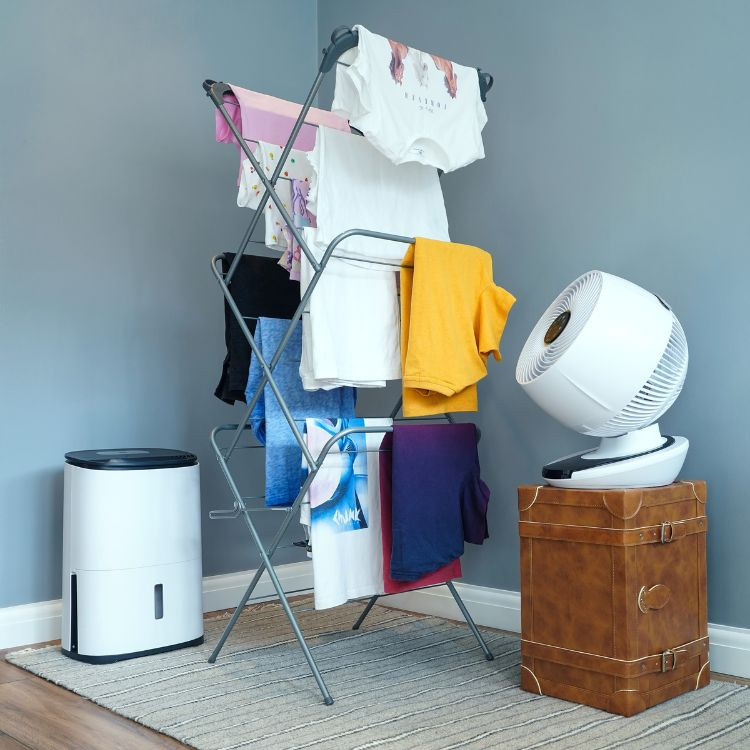Drying laundry faster and cheaper
24th Aug 2023
Despite the popularity of tumble dryers, consumers are increasingly looking for alternatives to these expensive-to-run appliances for drying their washing indoors. Tumble dryers typically demand a lot of energy, which is hard on the environment and on consumers' pockets. They also need dedicated placement and this is a big issue for smaller homes where space is limited. Also, the tumble dryer can be harsh on fabrics and not suitable for all material. Drying washing on radiators means paying for the cost of running them without any cost saving. Additionally, one should never dry washing on an electric radiator as this is a serious fire risk.
So what are the alternatives for drying laundry indoors?
For many this simply means hanging damp clothes around the house and waiting for them to dry naturally. Some opt for a heated airer and others set up elaborate drying rigs over a radiator with a bed sheet over the top to create a drying tent. All these solutions are flawed however, as none of the options deal with the moisture that comes off the clothes during the process.
Making matters worse
Drying clothes indoors quickly results in the the build up of moisture in the air and with that, potential mould and condensation issues. Repeated indoor laundry sessions just makes the moisture worse, and much more difficult to dry subsequent washing, eventually leading to smelly, damp clothes. The damp also has a big negative impact for the health of the people using the room, plus on the room and its contents which can become stained at best, ruined at worst.
Drying indoors in winter
In winter you could deal with excess moisture on days when the outside air temperature is colder than the internal room temperature by opening a window and letting the cold air in. But introducing that cold air will not be pleasant, and there is a hidden cost involved because you will have to heat all of that incoming cold air up, and the air in the house that you have already paid to heat will escape out of the house and you will be throwing money out of the window.
The dehumidifier solution
Consumers who have suffered from the above problems have subsequently discovered that a dehumidifier was the solution to the problem and would prevent mould and damp problems while drying clothes. Using a dehumidifier to dry your clothes might be a new concept for the Brits and Irish, but in many countries around the world it is a daily ritual. For example in Switzerland, apartment blocks are built with large communal drying areas in the basement with large industrial dehumidifiers blowing air across a washing line to allow the residents to dry their clothes quickly and efficiently.
Meaco to the rescue
In 2022, as the British public became desperate to find a cheaper (and safer) solution to the tumble dryer, word spread across social media and the national press that a dehumidifier was a feasible solution. Meaco was inundated with phone calls showing that the consumer was getting the message about the viability of the dehumidifier solution and they were interested. Meaco was in a great position to provide much sound advice on how best to dry laundry effectively using their dehumidifiers.
Here are some of Meaco's tips for laundry drying:
- Use the rinse cycle on your washing machine to remove as much water as possible before you remove the clothes from the machine.
- Place the washing on a clothes rack with the small items are the bottom of the clothes horse and the large items at the top.
- Don’t overload the rack by having clothes layered on top of each other.
- Place the dehumidifier at the open end of the rack.
- Place a Meaco fan at the opposite end of the rack and let it oscillate up and down.
- Turn the rack halfway through the drying process.
- Do all of the above in a small room (but larger than 4 square metres)
- Keep the relative humidity down in the house using the dehumidifier between loads so that you start off drying with a reasonable relative humidity in the first place.
What not to do:
- It is important to not use the dehumidifier in a very small room (less than 4 square metres) or a cupboard, the dehumidifier could just overheat and turn off in the space.
- Never allow water from the clothes to drip into the dehumidifier
- Don’t allow clothes to fall onto the dehumidifier
- Never block the air flow in or out of the dehumidifier
- Always keep the air inlet filter clean.
Here's to dry and soft clothes and a healthy indoor environment that protects you, your home and your possessions!



